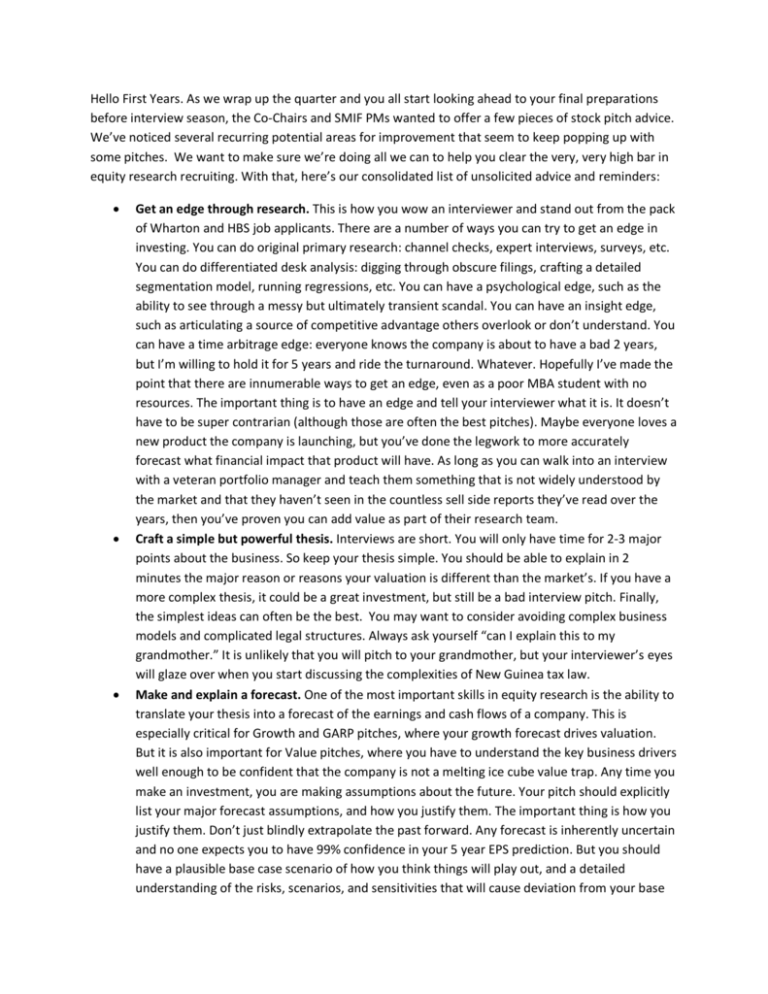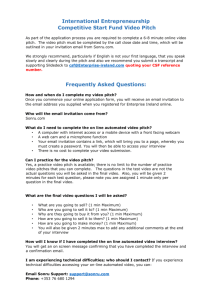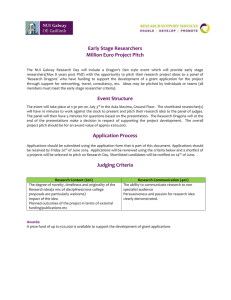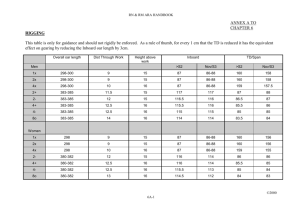Stock Pitch Advice - The University of Chicago Booth School of
advertisement

Hello First Years. As we wrap up the quarter and you all start looking ahead to your final preparations before interview season, the Co-Chairs and SMIF PMs wanted to offer a few pieces of stock pitch advice. We’ve noticed several recurring potential areas for improvement that seem to keep popping up with some pitches. We want to make sure we’re doing all we can to help you clear the very, very high bar in equity research recruiting. With that, here’s our consolidated list of unsolicited advice and reminders: • • • Get an edge through research. This is how you wow an interviewer and stand out from the pack of Wharton and HBS job applicants. There are a number of ways you can try to get an edge in investing. You can do original primary research: channel checks, expert interviews, surveys, etc. You can do differentiated desk analysis: digging through obscure filings, crafting a detailed segmentation model, running regressions, etc. You can have a psychological edge, such as the ability to see through a messy but ultimately transient scandal. You can have an insight edge, such as articulating a source of competitive advantage others overlook or don’t understand. You can have a time arbitrage edge: everyone knows the company is about to have a bad 2 years, but I’m willing to hold it for 5 years and ride the turnaround. Whatever. Hopefully I’ve made the point that there are innumerable ways to get an edge, even as a poor MBA student with no resources. The important thing is to have an edge and tell your interviewer what it is. It doesn’t have to be super contrarian (although those are often the best pitches). Maybe everyone loves a new product the company is launching, but you’ve done the legwork to more accurately forecast what financial impact that product will have. As long as you can walk into an interview with a veteran portfolio manager and teach them something that is not widely understood by the market and that they haven’t seen in the countless sell side reports they’ve read over the years, then you’ve proven you can add value as part of their research team. Craft a simple but powerful thesis. Interviews are short. You will only have time for 2-3 major points about the business. So keep your thesis simple. You should be able to explain in 2 minutes the major reason or reasons your valuation is different than the market’s. If you have a more complex thesis, it could be a great investment, but still be a bad interview pitch. Finally, the simplest ideas can often be the best. You may want to consider avoiding complex business models and complicated legal structures. Always ask yourself “can I explain this to my grandmother.” It is unlikely that you will pitch to your grandmother, but your interviewer’s eyes will glaze over when you start discussing the complexities of New Guinea tax law. Make and explain a forecast. One of the most important skills in equity research is the ability to translate your thesis into a forecast of the earnings and cash flows of a company. This is especially critical for Growth and GARP pitches, where your growth forecast drives valuation. But it is also important for Value pitches, where you have to understand the key business drivers well enough to be confident that the company is not a melting ice cube value trap. Any time you make an investment, you are making assumptions about the future. Your pitch should explicitly list your major forecast assumptions, and how you justify them. The important thing is how you justify them. Don’t just blindly extrapolate the past forward. Any forecast is inherently uncertain and no one expects you to have 99% confidence in your 5 year EPS prediction. But you should have a plausible base case scenario of how you think things will play out, and a detailed understanding of the risks, scenarios, and sensitivities that will cause deviation from your base • • • • • • • case. Also, know how your projections relate to unit economics and be able to translate forecasts to the bottom line and discuss how this impacts valuation. Become the world expert in your company. Interviewers will push you. One recruiter we spoke to recently said “I will ask probing questions until I reach the point where you don’t know the answer. I want to see what your breaking point is.” You never know what you could get asked about, so learn anything and everything you can about your company and its industry. But when you get stumped by a question you don’t have the answer to or a point you hadn’t considered, don’t try to BS your way out. No PM wants an analyst who pretends to know what they’re talking about – that’s extremely dangerous for an investment team. Also, a reminder about keeping it simple: just because you are the world expert on your company does not mean you need to prove you know everything about the company in the first two minutes of the conversation. Let this flow naturally from Q&A, and save your initial pitch for the key points and thesis. Think about catalysts. Time arbitrage is a great strategy for those funds and PMs that practice it. But all things being equal, catalysts are always a good thing to have. There’s no reason a stock can’t be both a good short-term and long-term investment. Know what upcoming newsflow is going to move the share price. Margin of safety – Invest scared. Make sure there’s a margin of safety in your stock. 25% is usually a good hurdle rate. You don’t know what you don’t know, or what mistakes you’ve made. This is especially important in interview season – the last thing you want is a stock running up 15% the day before you pitch to your dream firm. A big margin of safety will help shelter you from that risk. Momentum stocks are tricky for the same reason. Upside – Dangle the carrot. Discussing margin of safety is important but downside protection doesn’t get you bottle service at your favorite, overpriced bar or a date with that person who just wants you for your money. This is how PMs think. 20% is nice for a base case but tell them how it can turn into a double or a triple. Be very careful of microcap stocks. Some interviewers will be fine if you pitch a $100 million market cap stock, but others won’t be. Why risk it? If you are investing so much time into your flagship pitch for interview season, why not pick a billion-dollar-plus market cap company you are confident will work in any interview? If you have invested heavily in researching a microcap stock and have strong conviction, that’s great, but you may want to consider pitching it as a 2nd, 3rd, or 4th option. Also, be cognizant of what you pitch to SMIF PM’s. There is a rough minimum market cap of $1 billion for investments in the fund. Use forward multiples. Many of you are still using LTM multiples for your comp valuations. Honestly, there is usually no good excuse for doing this. Take the extra 10 minutes and get forward multiples from CapIQ or Bloomberg. This is a minor but important point and there is absolutely no reason for you to shoot yourself in the foot with an easily avoidable rookie mistake. Should I use a DCF or multiple based valuation? Both. Different firms (and different people within the same firm) will have different preferences. Some people take this to religious extremes and think anyone who uses the opposite approach is a fool, so be prepared. Ideally, • • • your pitch should look attractive on both a relative and intrinsic basis, that is, the two valuation approaches should confirm each other. In general, the more valuation approaches you try, the better informed you will be. What type of multiple should I use? Base your price target on one or two ratios that are most appropriate, but be prepared to talk about what your stock trades at on a wide range of multiples, whatever is applicable for the industry: EV/EBITDA, EV/EBIT, EV/(EBITDA-CAPEX), EV/Sales, P/E, P/Cash EPS, P/Book, replacement cost, NAV, free cash flow yield, dividend yield, and anything else we’ve forgotten. Know what each metric is telling you, and be prepared to defend the main multiple you use in your price target as the most appropriate choice. (For example, using EV/EBITDA or EV/EBIT rather than P/E when there are major capital structure differences among your comp set.) Similarly, look at many approaches for arriving at the right numerical multiple: don’t just use historical trading ranges. If you’re lost, check out what approaches the sell side is using in the industry, or ask a second year for advice… multiples analysis is definitely an art that takes some practice. Beyond the income statement. You should take a careful look at the balance sheet and cash flow statement. What cash is the company generating, what cash will it need to invest in the business, where is it getting extra cash it needs, and what is it doing with excess cash it generates? The vast majority of interviewers won’t ask you for anything close to a three statement model in an interview, but you can get asked some targeted questions. How much debt do they have? What are their CAPEX and working capital requirements like going forward? Will they have liquidity problems? Are they paying shareholders or squandering resources? It depends on what you’re pitching. For an all-equity-financed software company doing well, you can simply say “they run a capital-light business and have a totally clean balance sheet” and cover the issue in 5 seconds during your pitch. For a growing capital-intensive manufacturing company, you can say something like “I anticipate moderate CAPEX of $X over the next two years to support my growth forecast, but they should be able to pay for it with cash from operations; if they run into trouble, they are only at .5x Debt to EBITDA, and have $X of untapped credit facility, with no impending maturities, so they won’t have financing problems. Most likely, I anticipate they will initiate a share repurchase program when this CAPEX cycle is concluded.” For companies undergoing some distress, you need to do a deeper dive into the balance sheet issues. Interviewers will often have their laptops or Bloomberg terminal open during an interview, and if you try to pitch them a company in serious risk of bankruptcy without mentioning that risk, let’s just say it doesn’t reflect well on you. As a rule of thumb, if your company isn’t investment grade rated, you need to spend some time in your pitch on the balance sheet. Practice? Yes we’re talking ‘bout practice! Practice is key. The presentation and ability to convey a message is just as important as the underlying ideas. Think strategically about the story you are telling and what information is necessary to support it. The only way to get better is to practice and solicit feedback. One rule: don’t pitch us at TNDC. Best of luck and let us know how we can help!







